A Smart Hydration Device for Children: Leveraging TRIZ Methodology to Combat Dehydration and Enhance Cognitive Performance
Abstract
1. Introduction
2. Review of Existing Solutions and Research
3. Methodology
“Initial readings are not saved properly”.
3.1. Sub-Problem 1: Housing of Prototype Is Small
- Separation of contradictory requirements;
- Satisfaction of contradictory requirements;
- Bypass of contradictory requirements [62].
3.2. Proposed Concept: Smart Water Measuring, Accumulating, and Display Device
3.3. Component Selection
3.4. Programming Flowchart
- Individual facial recognition: identifying one registered user at a time via laptop-connected camera.
- Persistent data display: showing multiple users’ cumulative consumption on LCD.
3.5. Experimental Procedures
| Null Hypothesis, Ho | : | There is no significant difference in having the smart system between Situation A and Situation B. |
| Alternative Hypothesis, Ha | : | There is a significant difference in having the smart system between Situation A and Situation B. |
| Fixed | : | The type, size, and design of the container (or cup) used by the child throughout the experiment. |
| Recorded value | : | Volume of water drunk (mL). |
| Conditions | : |
|
- Firstly, the jar will be filled to the brim and the amount of water is recorded. Then, the jar is placed onto a table and a stopwatch is started to record the time.
- At every one-hour interval, parents are to remind their child to drink water.
- At the end of the fourth hour, the stopwatch is stopped and parents are to calculate the total amount of water drunk by the child. The result obtained will be recorded in a table.
- The experiment will be repeated for the second stage on a different day where instead of placing the filled water jar on the table, the jar is placed onto the device and the total amount of water will be measured automatically by the device.
- Then, parents are not to remind their children at every hour interval as they did in the first phase of the experiment. However, parents are to monitor the condition of the jar and ensure sufficient water is in the jar.
- At the end of the experiment (after four hours), parents are to request the child to stand in front of the device for a short time. Then, the smart system will display the total amount of water drunk by the child on the LCD screen.
- The result obtained is then tabulated on the same table (in a separate column).
| Null Hypothesis, Ho | : | There is no significant difference in having the smart system between Situation A and Situation B. |
| Alternative Hypothesis, Ha | : | There is a significant difference in having the smart system between Situation A and Situation B. |
| Fixed | : | The type, size, and design of the container (or cup) used by the child throughout the experiment. |
| Recorded value | : | Time taken in hours to finish up the prescribed amount of water for each child. |
| Conditions | : |
|
- For the first stage, the jar is filled with a specific amount of water depending on the prescribed amount of water consumption for the child.
- Then, the jar is placed onto a table and a stopwatch is started.
- Once the water in the jar has been fully consumed, the stopwatch is stopped.
- The time taken for the child to drink the water in Situation A is then recorded.
- The second phase of the experiment is carried out by filling the jar with the same amount of water again. However, the jar is placed onto the device instead and a stopwatch is used to start recording the time once the jar is placed onto the device.
- The stopwatch is then immediately stopped once the water has been fully consumed.
- The time taken to empty the jar for Situation A and Situation B are recorded and tabulated in a table.
| Null Hypothesis, Ho | : | There is no significant difference in having the smart system between Situation A and Situation B. |
| Alternative Hypothesis, Ha | : | There is a significant difference in having the smart system between Situation A and Situation B. |
| Fixed | : | The type, size, and design of the container (or cup) used by the child throughout the experiment. |
| Recorded value | : | Number of times the child drinks water within a five-hour period. |
| Conditions | : |
|
- The jar of water is filled at a full level and placed on a table.
- Then, the stopwatch is started using a five-hour-period timer.
- The child is then observed within the period and whenever he/she drinks water from the jar, the count (frequency) is recorded.
- The number of times the child drinks water within the five-hour period is then recorded and tabulated in a table.
- The experiment is repeated again with the jar of water filled at a full level.
- However, this time the jar is placed on the measuring platform of the smart device.
4. Discussion
4.1. Data Obtained from Experiments with Prototype
4.2. T-Test Analysis
- Data for each group were obtained through random sampling.
- The variances of the two groups were unequal.
- Data in each group were normally distributed.
- Measurement values were continuous.
4.3. Tabulation of Significance Levels
4.4. Discussions and Findings
- Participants frequently reminded each other to drink water.
- Cognitive performance among participants improved.
- Participants became more aware of the amount of water they consumed.
5. Conclusions
5.1. Participants Reminded Each Other to Drink Water
5.2. Improved Cognitive Performance Among Participants
5.3. Participants Aware of Amount of Water Consumed
5.4. Challenges and Limitations of Study
5.5. Directions for Future Research
Author Contributions
Funding
Data Availability Statement
Acknowledgments
Conflicts of Interest
Abbreviations
| TRIZ | Theory of Inventive Problem Solving |
| CEC | Cause-and-Effect Chain |
| LCD | Liquid Crystal Display |
| AI | Artificial Intelligence |
References
- Khazanah Research Institute. Rising Temperature Due to Climate Change Pose Increasing Risks to Malaysia’s Public Health; Khazanah Research Institute: Kuala Lumpur, Malaysia, 2024. [Google Scholar]
- Mehnert, P.; Malchaire, J.; Kampmann, B.; Piette, A.; Griefahn, B.; Gebhardt, H. Prediction of the Average Skin Temperature in Warm and Hot Environments. Eur. J. Appl. Physiol. 2000, 82, 52–60. [Google Scholar] [CrossRef] [PubMed]
- Akerman, A.P.; Tipton, M.; Minson, C.T.; Cotter, J.D. Heat Stress and Dehydration in Adapting for Performance: Good, Bad, Both, or Neither? Temperature 2016, 3, 412–436. [Google Scholar] [CrossRef] [PubMed]
- Yau, Y.; Chew, B.T.; Saifullah, A.Z.A. Thermal Comfort Temperature Range Study for Workers in a Factory in Malaysia. Am. J. Eng. Res. 2012, 2, 1218–1223. [Google Scholar]
- Laman Web Rasmi Jabatan Meteorologi Malaysia. Available online: https://www.met.gov.my/ (accessed on 28 May 2025).
- Malaysia Record High and Low Temperature (Celsius) Map and List-Updated May 2025. Available online: www.plantmaps.com (accessed on 28 May 2025).
- D’Anci, K.E.; Constant, F.; Rosenberg, I.H. Hydration and Cognitive Function in Children. Nutr. Rev. 2006, 64, 457–464. [Google Scholar] [CrossRef]
- Louis, G.B.; Programme, U.N.E.; Organisation, I.L. Principles for Evaluating Health Risks in Children Associated with Exposure to Chemicals; World Health Organization: Geneva, Switzerland, 2006; ISBN 978-92-4-157237-8. [Google Scholar]
- EFSA Panel on Dietetic Products, Nutrition, and Allergies (NDA). Scientific Opinion on Dietary Reference Values for Water. EFSA J. 2010, 8, 1459. [Google Scholar] [CrossRef]
- Kaur, S.; Tung, S.; Maykanathan, D.; Lim, Y.Y. The Association of the Hydration Status and Parental Knowledge on Fluid Consumption with Children’s Weight Status in Malaysia. Sri Lanka J. Child Health 2017, 46, 222. [Google Scholar] [CrossRef]
- Ganio, M.S.; Armstrong, L.E.; Casa, D.J.; McDermott, B.P.; Lee, E.C.; Yamamoto, L.M.; Marzano, S.; Lopez, R.M.; Jimenez, L.; Bellego, L.L.; et al. Mild Dehydration Impairs Cognitive Performance and Mood of Men. Br. J. Nutr. 2011, 106, 1535–1543. [Google Scholar] [CrossRef]
- Gopinathan, P.M.; Pichan, G.; Sharma, V.M. Role of Dehydration in Heat Stress-Induced Variations in Mental Performance. Arch. Environ. Health Int. J. 1988, 43, 15–17. [Google Scholar] [CrossRef]
- Aksoy, A.; Oğur, S.; Toprak, S.; Kızılkanat, K.; Mirioğlu, Y.; Kaldık, B. The Role of Parents in the Attainment of Water or Liquid Consumption Behavior in Children. J. Occup. Environ. Med. 2017, 2, 21. [Google Scholar]
- Shi, Y.; Qu, S. Cognition and Academic Performance: Mediating Role of Personality Characteristics and Psychology Health. Front. Psychol. 2021, 12, 774548. [Google Scholar] [CrossRef]
- Owen, K.B.; Foley, B.C.; Wilhite, K.; Booker, B.; Lonsdale, C.; Reece, L.J. Sport Participation and Academic Performance in Children and Adolescents: A Systematic Review and Meta-Analysis. Med. Sci. Sports Exerc. 2022, 54, 299–306. [Google Scholar] [CrossRef] [PubMed]
- Mason, L.; Ronconi, A.; Scrimin, S.; Pazzaglia, F. Short-Term Exposure to Nature and Benefits for Students’ Cognitive Performance: A Review. Educ. Psychol. Rev. 2022, 34, 609–647. [Google Scholar] [CrossRef]
- Hernández-Jaña, S.; Sanchez-Martinez, J.; Solis-Urra, P.; Esteban-Cornejo, I.; Castro-Piñero, J.; Sadarangani, K.P.; Aguilar-Farias, N.; Ferrari, G.; Cristi-Montero, C. Mediation Role of Physical Fitness and Its Components on the Association Between Distribution-Related Fat Indicators and Adolescents’ Cognitive Performance: Exploring the Influence of School Vulnerability. Cogni-Action. Project. Front. Behav. Neurosci. 2021, 15, 746197. [Google Scholar] [CrossRef] [PubMed]
- Chaarani, B.; Ortigara, J.; Yuan, D.; Loso, H.; Potter, A.; Garavan, H.P. Association of Video Gaming With Cognitive Performance Among Children. JAMA Netw. Open 2022, 5, e2235721. [Google Scholar] [CrossRef]
- Dong, J.; Schwartz, Y.; Korolija, I.; Mumovic, D. The Impact of Climate Change on Cognitive Performance of Children in English School Stock: A Simulation Study. Build. Environ. 2023, 243, 110607. [Google Scholar] [CrossRef]
- Michel, L.C.; McCormick, E.M.; Kievit, R.A. Gray and White Matter Metrics Demonstrate Distinct and Complementary Prediction of Differences in Cognitive Performance in Children: Findings from ABCD (N = 11,876). J. Neurosci. 2024, 44, e0465232023. [Google Scholar] [CrossRef]
- Lima, R.A.; Soares, F.C.; van Poppel, M.; Savinainen, S.; Mäntyselkä, A.; Haapala, E.A.; Lakka, T. Determinants of Cognitive Performance in Children and Adolescents: A Populational Longitudinal Study. Int. J. Environ. Res. Public Health 2022, 19, 8955. [Google Scholar] [CrossRef]
- Anderson, P. Assessment and Development of Executive Function (EF) During Childhood. Child. Neuropsychol. 2002, 8, 71–82. [Google Scholar] [CrossRef]
- Ullman, H.; Almeida, R.; Klingberg, T. Structural Maturation and Brain Activity Predict Future Working Memory Capacity during Childhood Development. J. Neurosci. 2014, 34, 1592–1598. [Google Scholar] [CrossRef]
- Rashid, A.F.; Wafa, S.W.; Abd Talib, R.; Abu Bakar, N.M. An Interactive Malaysian Childhood Healthy Lifestyle (i-MaCHeL) Intervention Programme to Change Weight-Related Behaviour in Preschool Child-Parent Dyads: Study Protocol of a Cluster Randomised Controlled Trial. PLoS ONE 2022, 17, e0276843. [Google Scholar] [CrossRef]
- Malaysia To Break Record for Most People Drinking Water Simultaneously|TRP. 2023. Available online: https://www.therakyatpost.com/ (accessed on 25 May 2025).
- Long, C.; Suh, H.; Seal, A.D.; Bottin, J.; Summers, L.; Mauromoustakos, A. Relationship Between Parent and Child Water Intake and Hydration Habits. Curr. Dev. Nutr. 2024, 8, 102301. [Google Scholar] [CrossRef]
- Starovoytova, D. Theory of Inventive Problem Solving (TRIZ): His-Story. IJISET 2015, 2, 86–95. [Google Scholar]
- Altshuller, G.S. Creativity as an Exact Science; CRC Press: London, UK, 1984; ISBN 978-0-429-07379-3. [Google Scholar]
- Al’tshuller, G.S. The Innovation Algorithm: TRIZ, Systematic Innovation and Technical Creativity; Technical Innovation Center, Inc.: Worcester, MA, USA, 1999; ISBN 978-0-9640740-4-0. [Google Scholar]
- Souchkov, V. Breakthrough Thinking with TRIZ for Business and Management: An Overview; ICG Training and Consulting: Enschede, The Netherlands, 2017. [Google Scholar]
- Jiang, S.; Li, W.; Qian, Y.; Zhang, Y.; Luo, J. AutoTRIZ: Automating Engineering Innovation with TRIZ and Large Language Models. Adv. Eng. Inform. 2025, 65, 103312. [Google Scholar] [CrossRef]
- Shie, A.-J.; Xu, E.-M.; Wang, Y.; Yang, M.; Wu, Y.J. Emotional Needs and Service Process Optimization in Combined Medical and Elder Care: A TRIZ Approach. Technovation 2025, 143, 103224. [Google Scholar] [CrossRef]
- Lee, C.K.M.; Liang, J.; Yung, K.L.; Keung, K.L. Generating TRIZ-Inspired Guidelines for Eco-Design Using Generative Artificial Intelligence. Adv. Eng. Inform. 2024, 62, 102846. [Google Scholar] [CrossRef]
- Malvik, T.O. TRIZ as an Innovation Tool for Opportunity Management and Lean Construction. Procedia Comput. Sci. 2025, 256, 1459–1466. [Google Scholar] [CrossRef]
- Rong, H.; Liu, W.; Li, J.; Zhou, Z. Product Innovation Design Process Combined Kano and TRIZ with AD: Case Study. PLoS ONE 2024, 19, e0296980. [Google Scholar] [CrossRef]
- Santoso, G.; Ammarullah, M.I.; Sugiharto, S.; Hidayat, T.; Khoeron, S.; Bayuseno, A.P.; Jamari, J. TRIZ-Based Method for Developing a Conceptual Laparoscopic Surgeon’s Chair. Cogent Eng. 2024, 11, 2298786. [Google Scholar] [CrossRef]
- Noori, A.; Bonakdari, H.; Salimi, A.; Masoompour, J.; Pourkarimi, L. A Novel Multiple Attribute Decision-Making Approach for Assessing the Effectiveness of Advertising to a Target Audience on Drinking Water Consumers’ Behavior Considering Age and Education Level. Habitat Int. 2023, 133, 102749. [Google Scholar] [CrossRef]
- Garcia-Garcia, D. Health Promotion and Hydration: A Systematic Review About Hydration Care. Florence Nightingale J. Nurs. 2022, 30, 310–321. [Google Scholar] [CrossRef]
- Kavouras, S.A.; Arnaoutis, G.; Makrillos, M.; Garagouni, C.; Nikolaou, E.; Chira, O.; Ellinikaki, E.; Sidossis, L.S. Educational Intervention on Water Intake Improves Hydration Status and Enhances Exercise Performance in Athletic Youth. Scand. J. Med. Sci. Sports 2012, 22, 684–689. [Google Scholar] [CrossRef] [PubMed]
- Tan, R.E.J.H.; Ng, P.K.; Tan, D.W.H.; Lim, W.S. A Triz-Directed Approach in Proposing Device-Oriented Ideas That Cultivate Water-Drinking Habits among Children. Cogent Eng. 2021, 8, 1868134. [Google Scholar] [CrossRef]
- Tate, D.F.; Turner-McGrievy, G.; Lyons, E.; Stevens, J.; Erickson, K.; Polzien, K.; Diamond, M.; Wang, X.; Popkin, B. Replacing Caloric Beverages with Water or Diet Beverages for Weight Loss in Adults: Main Results of the Choose Healthy Options Consciously Everyday (CHOICE) Randomized Clinical Trial. Am. J. Clin. Nutr. 2012, 95, 555–563. [Google Scholar] [CrossRef] [PubMed]
- Fadda, R.; Rapinett, G.; Grathwohl, D.; Parisi, M.; Fanari, R.; Calò, C.M.; Schmitt, J. Effects of Drinking Supplementary Water at School on Cognitive Performance in Children. Appetite. 2012, 59, 3. [Google Scholar] [CrossRef]
- Edmonds, C.; Burford, D. Should Children Drink More Water? The Effects of Drinking Water on Cognition in Children. Appetite 2009, 52, 776–779. [Google Scholar] [CrossRef]
- Wernow, K.A.; Wernow, H.L. Communicative Water Bottle and System Thereof. U.S. Patent No 9,792,409, 2 July 2015. [Google Scholar]
- Pollio, M.J. Dieter’s water intake quantity tracking vessel. U.S. Patent No 20,080,257,898, 23 October 2008. [Google Scholar]
- Bischoff, J.A.; Bischoff, B.J. Liquid Consumption Counters. U.S. Patent No 9,003,999, 4 April 2015. [Google Scholar]
- Lin, Y. Apparatus for Monitoring Water Drinking Device. U.S. Patent No 20,100,164,709, 1 July 2010. [Google Scholar]
- Chang, S.; Chang, S. Drinking Water Reminding System and Reminding Method Thereof. U.S. Patent No 20,140,046,596, 13 February 2014. [Google Scholar]
- Kang, C.Q.; Ng, P.K.; Liew, K.W. The Conceptual Synthesis and Development of a Multifunctional Lawnmower. Inventions 2021, 6, 38. [Google Scholar] [CrossRef]
- Ng, P.K.; Prasetio, M.D.; Liew, K.W.; Lim, B.K.; Oktafiani, A.; Salma, S.A.; Safrudin, Y.N. A TRIZ-Inspired Conceptual Development of a Roof Tile Transportation and Inspection System. Buildings 2022, 12, 1456. [Google Scholar] [CrossRef]
- Ng, P.K.; Jee, K.S. Design and Development of an Ergonomic Milling Machine Control Knob Using TRIZ Principles. AJAS 2016, 13, 451–458. [Google Scholar] [CrossRef]
- Lim, S.H.; Ng, P.K. Synthesisation of Design Features for Multifunctional Stretcher Concepts. J. Med. Eng. Technol. 2021, 45, 145–157. [Google Scholar] [CrossRef]
- Lim, S.H.; Ng, P.K. The Design and Development of a Foldable Wheelchair Stretcher. Inventions 2021, 6, 35. [Google Scholar] [CrossRef]
- Ng, P.K.; Saptari, A.; Yeow, J.A. Synthesising the Roles of Torque and Sensation in Pinch Force: A Framework. Theor. Issues Ergon. Sci. 2014, 15, 193–204. [Google Scholar] [CrossRef]
- Cheng, H.Y.; Ng, P.K.; Nathan, R.J.; Saptari, A.; Ng, Y.J.; Yeow, J.A.; Ng, K.Y. The Conceptualisation and Development of a Space-Saving Multipurpose Table for Enhanced Ergonomic Performance. Inventions 2021, 6, 67. [Google Scholar] [CrossRef]
- Budynas, R.G.; Nisbett, K.J.; Nisbett, J.K.; Shigley, J.E. Mcgraw-Hill series in mechanical engineering. In Shigley’s Mechanical Engineering Design, 10th ed.; McGraw-Hill Education: New York, NY, USA, 2015; ISBN 978-0-07-339820-4. [Google Scholar]
- Swee, N.S.L.; Toh, G.G.; Yip, M.W.; Keong, C.S.; Tai, S.C. Applying Triz for Production Quality Improvement. MATEC Web Conf. 2017, 95, 10009. [Google Scholar] [CrossRef]
- Chan, Y.W.; Chen, T.F.; Siow, K.S.; Majlis, B.Y.; Yeoh, T.S. TRIZ Technique to Produce Stable Plasma Modified Surfaces with High Density of Reactive Chemical Functionalities. In Proceedings of the 2015 IEEE Conference on Sustainable Utilization and Development in Engineering and Technology (CSUDET), Selangor, Malaysia, 15–17 October 2015; pp. 1–6. [Google Scholar]
- Mazlan, S.N.H.; Abdul Kadir, A.Z.; Deja, M.; Zieliński, D.; Alkahari, M.R. Development of Technical Creativity Featuring Modified TRIZ-AM Inventive Principle to Support Additive Manufacturing. J. Mech. Des. 2022, 144, 052001. [Google Scholar] [CrossRef]
- Souchkov, V. TRIZ: Theory of Solving Inventive Problems to Support Engineering Innovation in Maritime Industry. Zesz. Nauk. Akad. Morskiej Szczecinie 2018, 55, 9–19. [Google Scholar] [CrossRef]
- Chou, J.-R. An Ideation Method for Generating New Product Ideas Using TRIZ, Concept Mapping, and Fuzzy Linguistic Evaluation Techniques. Adv. Eng. Inform. 2014, 28, 441–454. [Google Scholar] [CrossRef]
- Litvin, S.S. Physical Contradictions Resolving with Inventive Principles; TRIZ Consulting Group: Sulzbach, Germany, 1987; pp. 1–9. [Google Scholar]
- TRIZ Separation Principles. Available online: https://www.quality-assurance-solutions.com/TRIZ-Separation-Principles.html (accessed on 26 May 2025).
- MATRIZ. Level 1 Training Manual; MATRIZ-The International TRIZ Association: Petrozavodsk, Russia, 2019; pp. 1–129. [Google Scholar]
- Beckmann, H. Method for Transferring the 40 Inventive Principles to Information Technology and Software. Procedia Eng. 2015, 131, 993–1001. [Google Scholar] [CrossRef]
- Güven, Y.; Coşgun, E.; Kocaoğlu, S.; Gezici, H.; Yılmazlar, E. Understanding the Concept of Microcontroller Based Systems to Choose the Best Hardware for Applications. Res. Inven. Int. J. Eng. Sci. 2017, 6, 38–44. [Google Scholar]
- Rajan, C.; Megala, B.; Nandhini, A.; Rasi Priya, C. A Review: Comparative Analysis of Arduino Micro Controllers in Robotic Car. World Acad. Sci. Eng. Technol. Int. J. Mech. Mater. Eng. 2015, 9, 371–381. [Google Scholar]
- Yeo, B.-C.; LIm, W.S.; Lim, H.S. Lane Detection in the Absence of Lane Markings for Roadway Surveillance with Thermal Vision. Int. J. Innov. Comput. Inf. Control 2015, 12, 677–688. [Google Scholar]
- Yeo, B.C.; Lim, H.S.; Lim, W.S. Vehicle Detection for Thermal Vision-Based Traffic Monitoring System Using Principal Component Analysis. Int. J. Innov. Comput. Inf. Control (IJICIC) 2016, 12, 1467. [Google Scholar]
- Saunders, G. Using Program Flowcharts in the Development of Macros for Spreadsheet Applications. J. Account. Educ. 1992, 10, 211–214. [Google Scholar] [CrossRef]
- Sedgwick, P.; Greenwood, N. Understanding the Hawthorne Effect. BMJ 2015, 351, h4672. [Google Scholar] [CrossRef] [PubMed]
- Rosnelly, R.; Simanjuntak, M.S.; Clinton Sitepu, A.; Azhari, M.; Kosasi, S. Husen Face Recognition Using Eigenface Algorithm on Laptop Camera. In Proceedings of the 2020 8th International Conference on Cyber and IT Service Management (CITSM), Pangkal Pinang, Indonesia, 23–24 October 2020; pp. 1–4. [Google Scholar]
- Saputra, D.I.S.; Amin, K.M. Face Detection and Tracking Using Live Video Acquisition in Camera Closed Circuit Television and Webcam. In Proceedings of the 2016 1st International Conference on Information Technology, Information Systems and Electrical Engineering (ICITISEE), Yogyakarta, Indonesia, 23–24 August 2016; pp. 154–157. [Google Scholar]
- Gardner, B.; Lally, P.; Wardle, J. Making Health Habitual: The Psychology of ‘Habit-Formation’ and General Practice. Br. J. Gen. Pract. 2012, 62, 664–666. [Google Scholar] [CrossRef] [PubMed]
- Larsson, I.; Lissner, L.; Wilhelmsen, L. The “Green Keyhole” Revisited: Nutritional Knowledge May Influence Food Selection. Eur. J. Clin. Nutr. 1999, 53, 776–780. [Google Scholar] [CrossRef]
- Bar-David, Y.; Urkin, J.; Kozminsky, E. The Effect of Voluntary Dehydration on Cognitive Functions of Elementary School Children. Acta Paediatr. 2005, 94, 1667–1673. [Google Scholar] [CrossRef]
- Booth, P.; Hunyadvari, N.; Dawkins, L.; Moore, D.; Gentile-Rapinett, G.; Edmonds, C.J. Water Consumption Increases Handwriting Speed and Volume Consumed Relates to Increased Finger-Tapping Speed in Schoolchildren. J. Cogn. Enhanc. 2022, 6, 183–191. [Google Scholar] [CrossRef]
- Fryling, M.J.; Johnston, C.; Hayes, L.J. Understanding Observational Learning: An Interbehavioral Approach. Anal. Verbal Behav. 2011, 27, 191–203. [Google Scholar] [CrossRef]
- Yoon, H.; Scopelliti, I.; Morewedge, C.K. Decision Making Can Be Improved through Observational Learning. Organ. Behav. Hum. Decis. Process. 2021, 162, 155–188. [Google Scholar] [CrossRef]
- Kaushik, A.; Mullee, M.A.; Bryant, T.N.; Hill, C.M. A Study of the Association Between Children’s Access to Drinking Water in Primary Schools and Their Fluid Intake: Can Water Be ‘Cool’ in School? Child: Care Health Dev. 2007, 33, 409–415. [Google Scholar] [CrossRef]
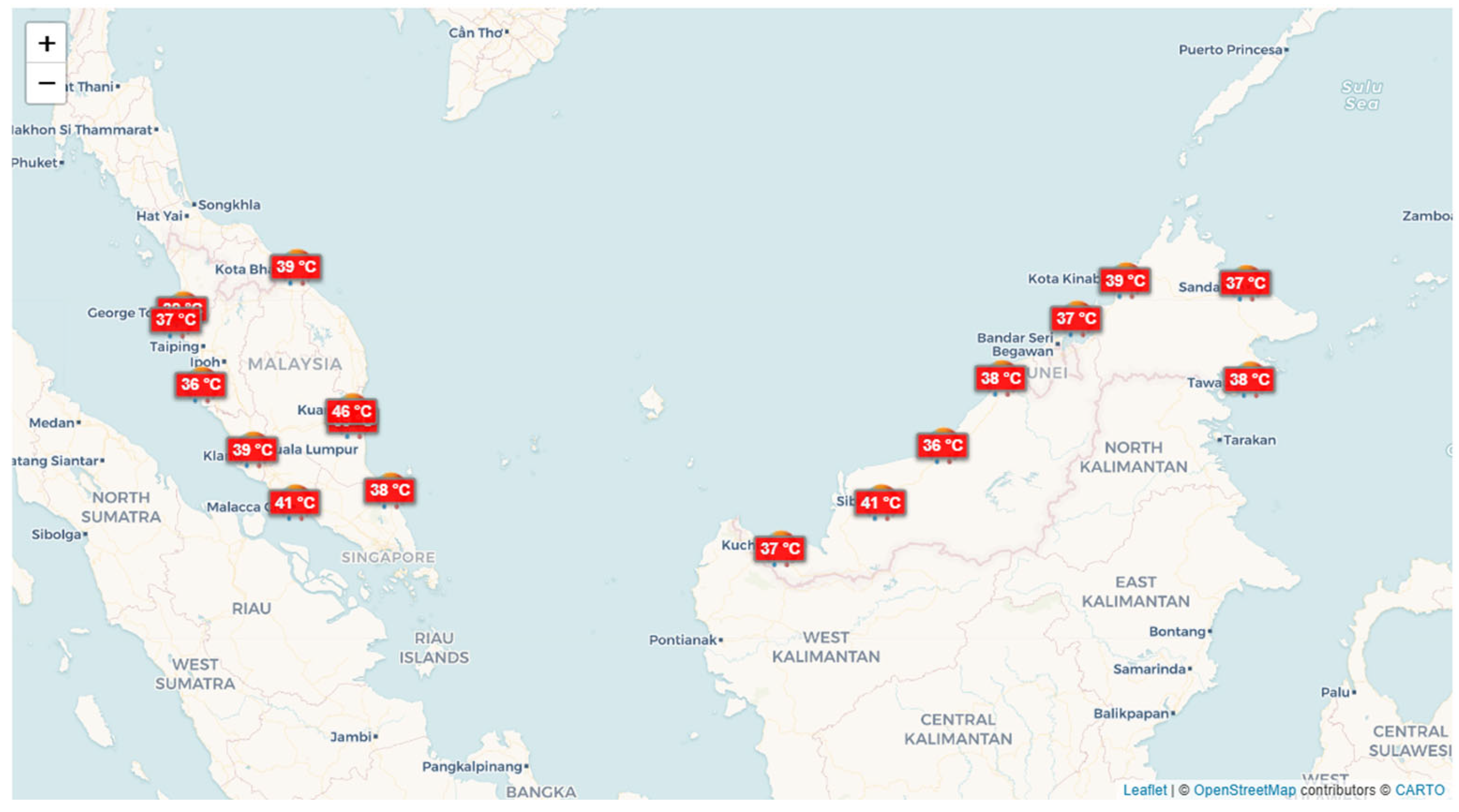

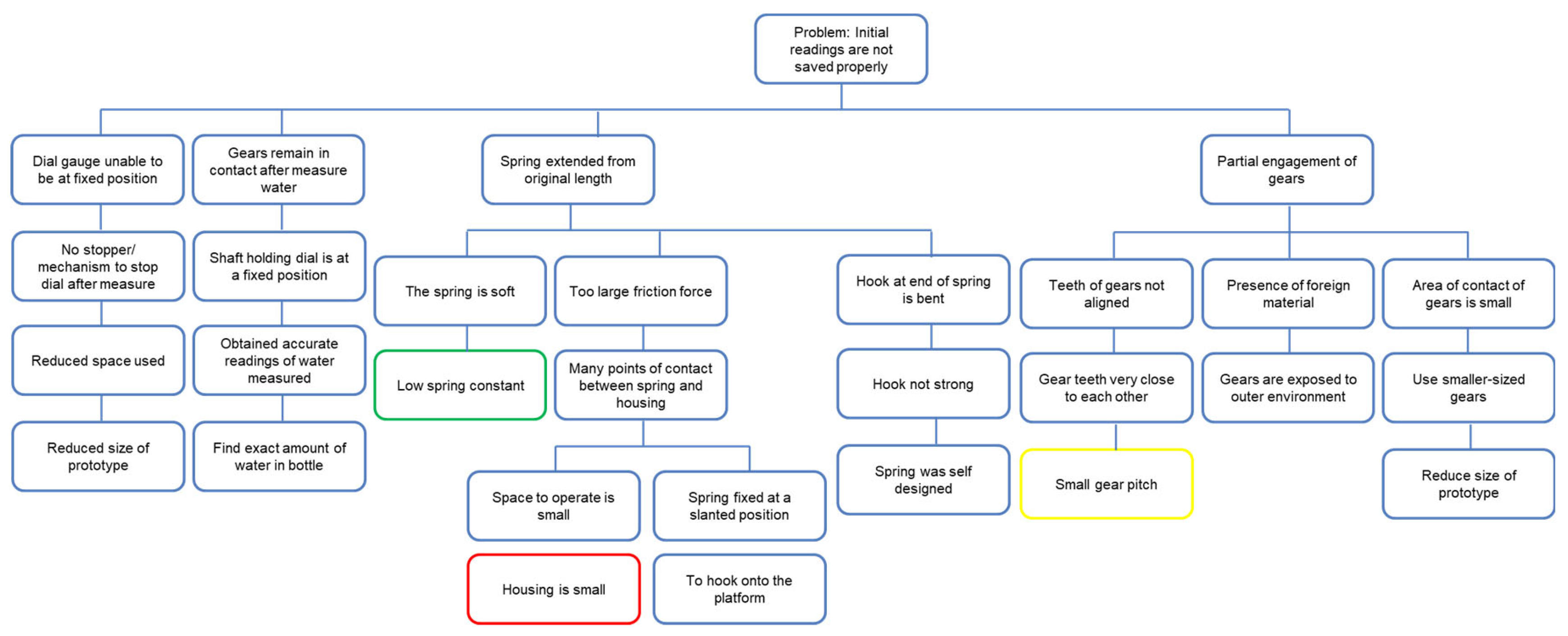
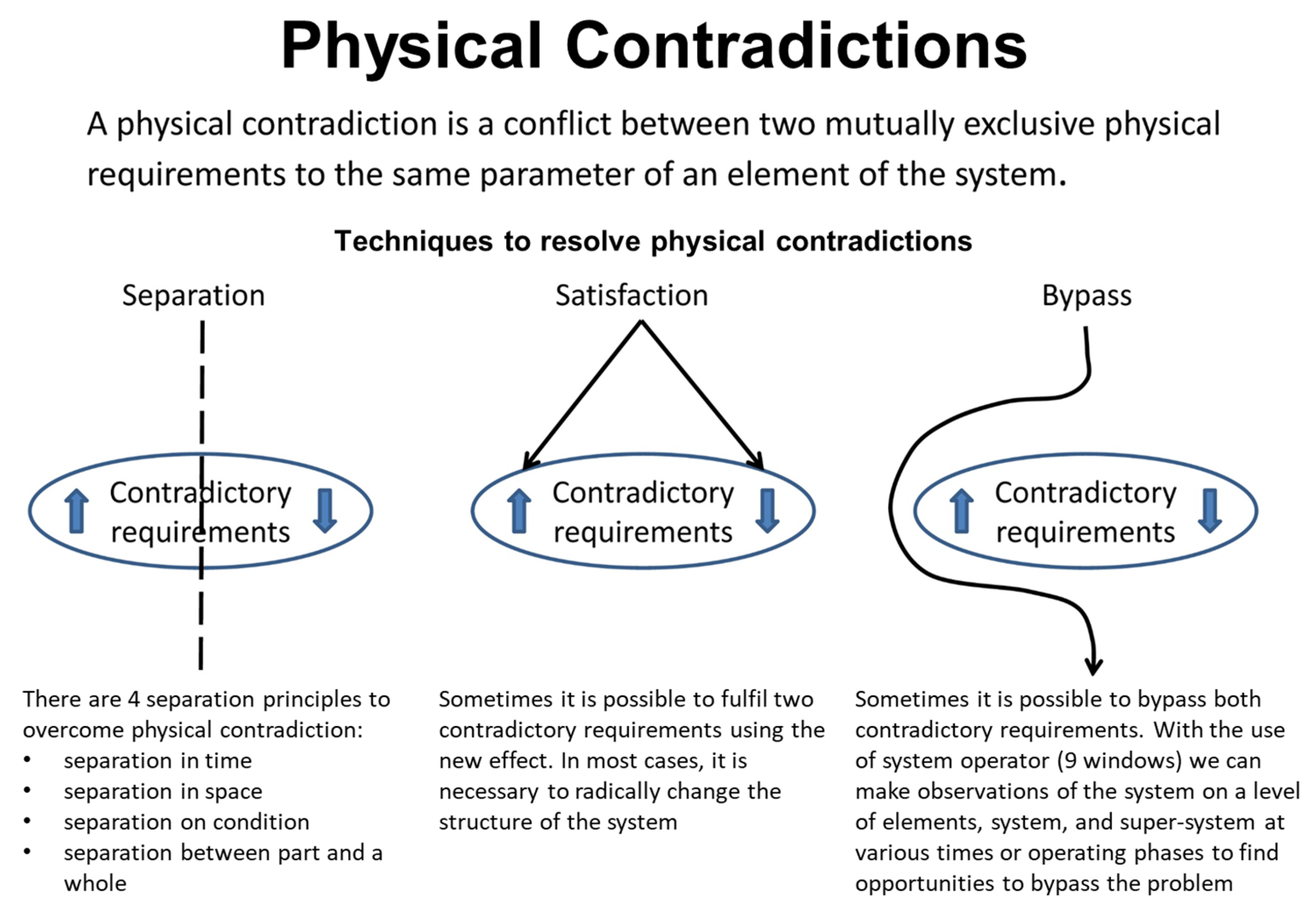

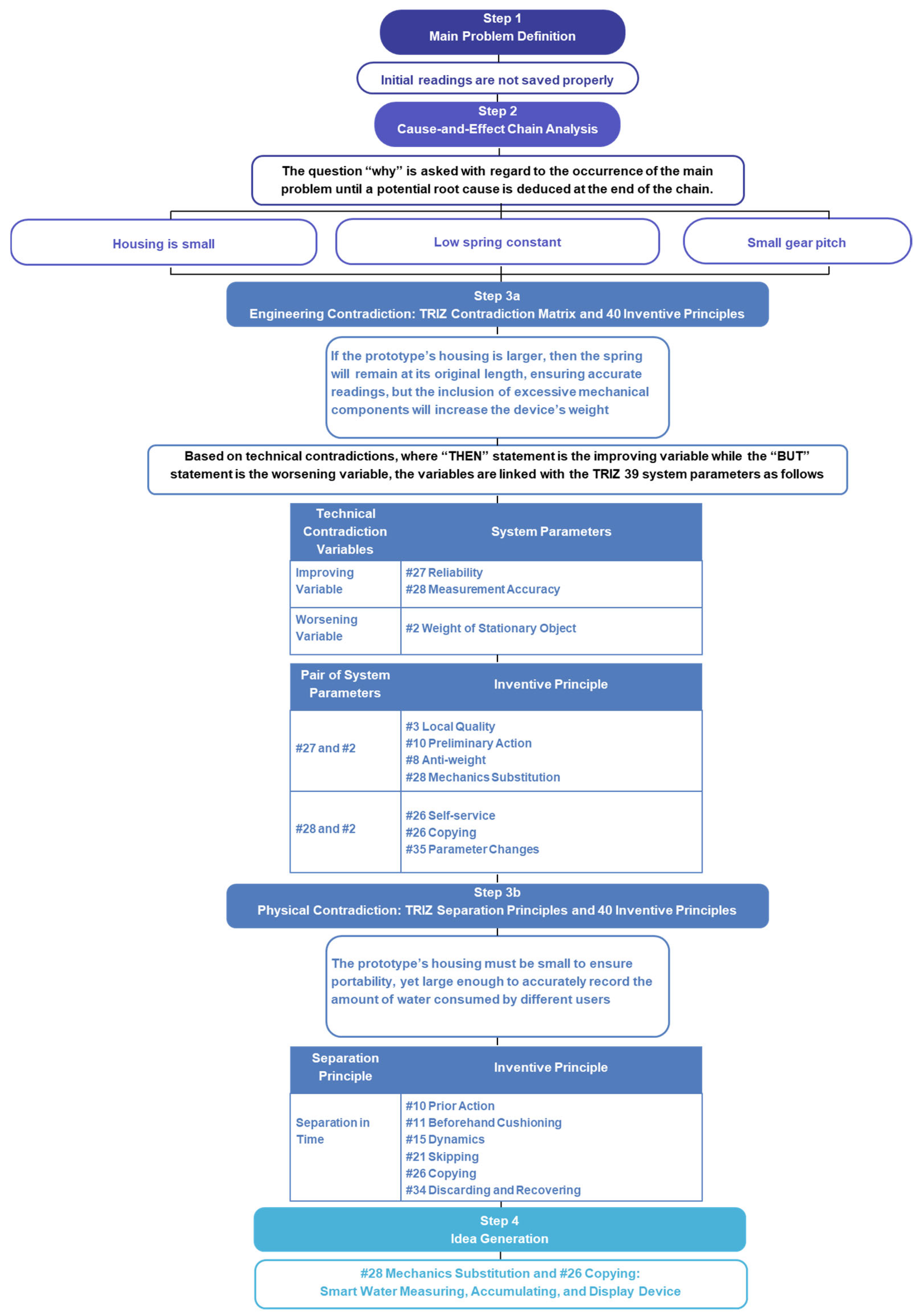
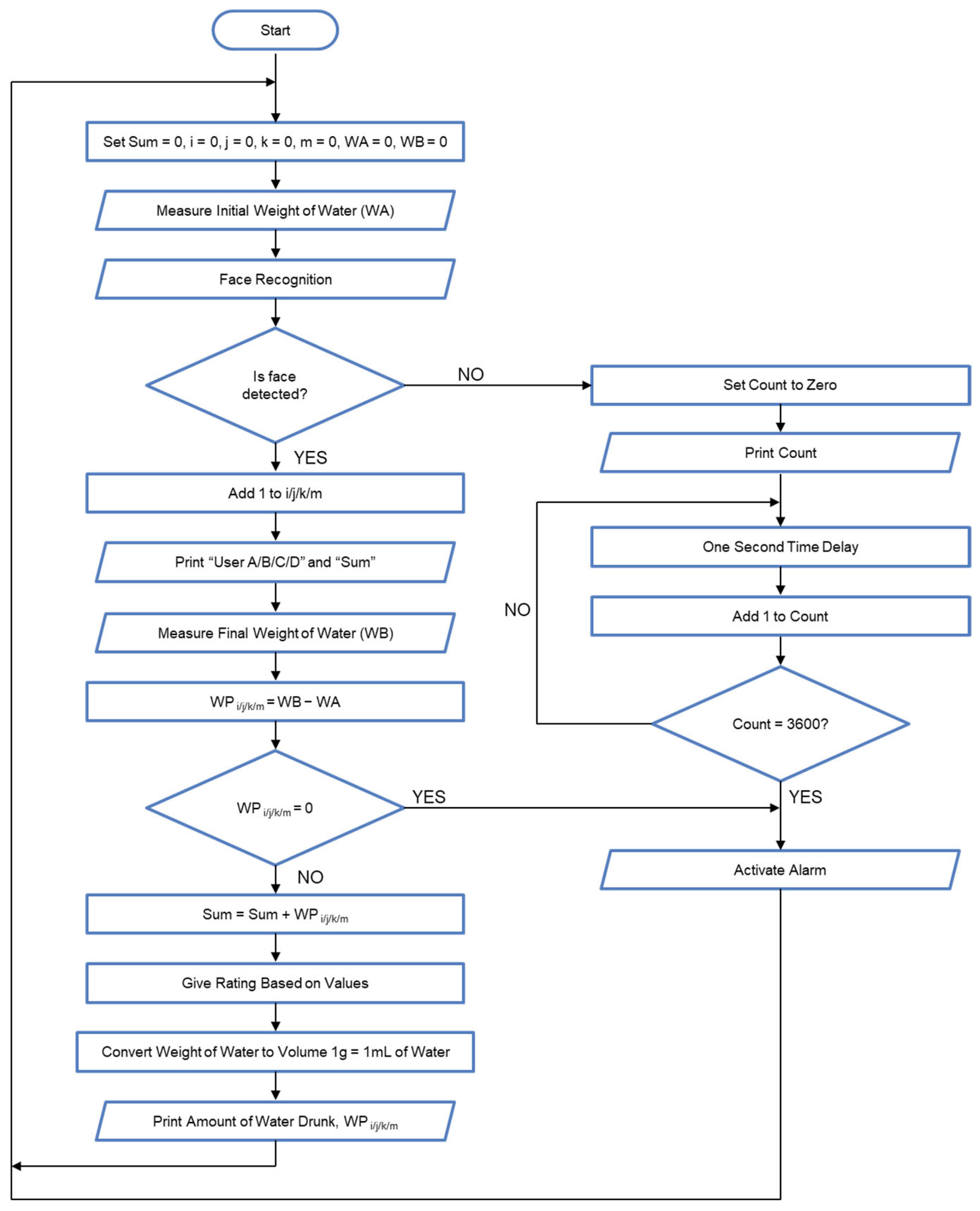
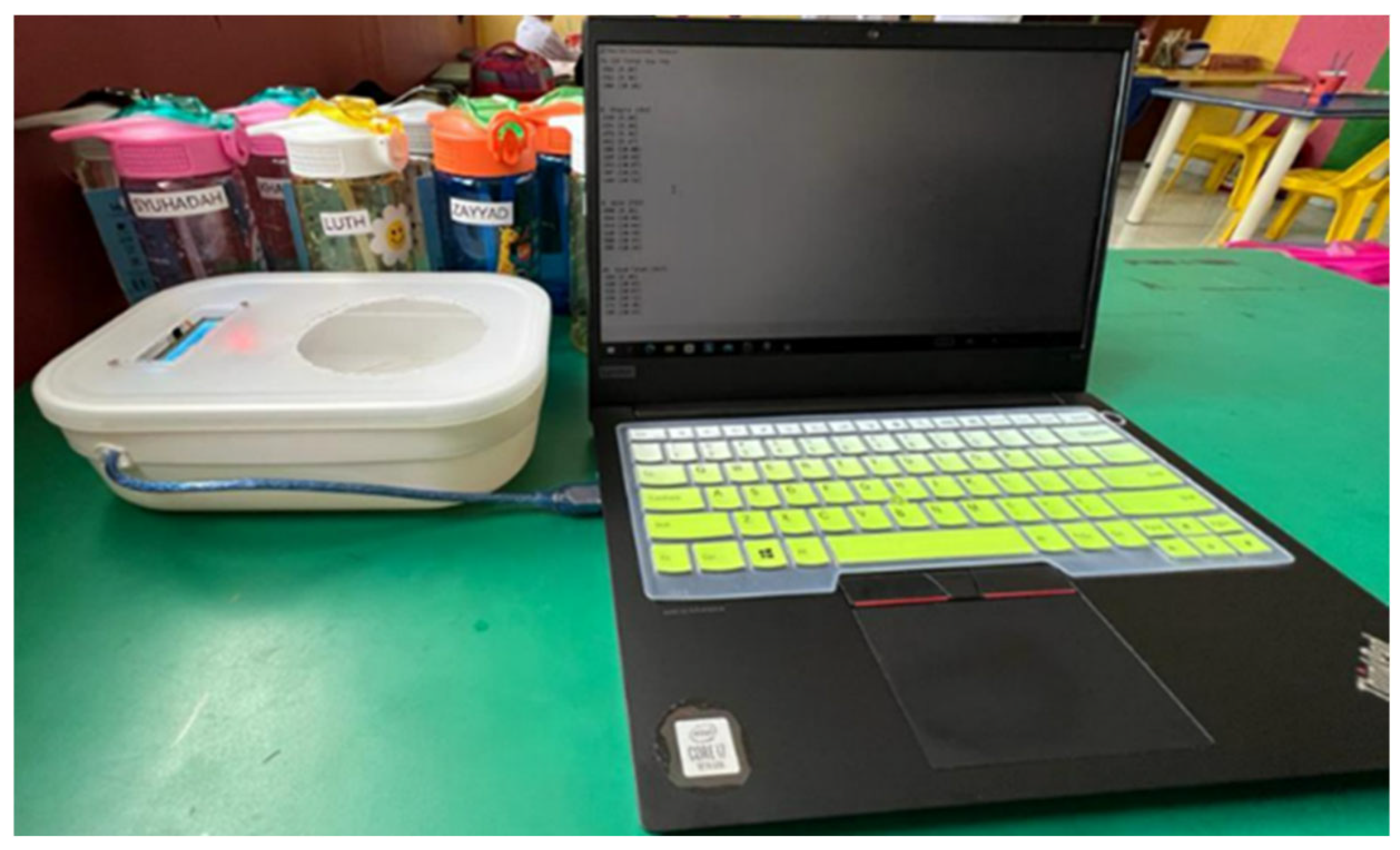



| Age Range (Years) | Adequate Intake (AI) (mL/day) | |
|---|---|---|
| Boy | Girl | |
| 1–2 | 1100 to 1200 | |
| 2–3 | 1300 | |
| 4–8 | 1600 | |
| 9–13 | 2100 | 1900 |
| 14 and above | 2500 | 2000 |
| Preliminary Ideas | Characteristics/Advantages of Preliminary Idea | Possible Limitations Observed |
|---|---|---|
Preliminary Idea 1: Dual Compartment Water Bottle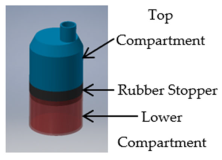 |
|
|
| Preliminary Idea 2: Water Measuring, Accumulating, and Displaying (M.A.D) Device Version 1  |
|
|
| Preliminary Idea 3: Water Measuring, Accumulating, and Displaying (M.A.D) Device Version 2 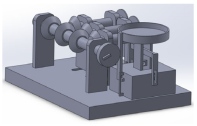 |
|
|
| Preliminary Idea 4: Water Measuring, Accumulating, and Displaying (M.A.D) Device Version 3  |
|
|
| Engineering Contradiction Variables | System Parameters |
|---|---|
| Improving Variable | #27 Reliability #28 Measurement Accuracy |
| Worsening Variable | #2 Weight of Stationary Object |
| Pairs of System Parameters | Inventive Principle |
|---|---|
| #27 and #2 | #3 Local Quality #10 Preliminary Action #8 Anti-weight #28 Mechanics Substitution |
| #28 and #2 | #25 Self-service #26 Copying #35 Parameter Changes |
| Components | Selection Criteria | Types/Choices Available |
|---|---|---|
| Microcontroller |
|
|
| Speakers |
|
|
| Weight Detection Sensor (Load Cell) |
|
|
| Camera/Webcam |
|
|
| LCD Screen Display |
|
|
| Portable Power Supply |
|
|
| Selection Criteria | Types of Microcontrollers | ||
|---|---|---|---|
| Arduino Uno (Reference) | Arduino Mega 2560 | Arduino Due | |
| Cost | 0 | − | − |
| Task efficiency (Speed) | 0 | + | + |
| Availability | 0 | 0 | − |
| Storage | 0 | + | 0 |
| Digital I/O pins | 0 | + | + |
| Sum of + | 0 | 3 | 2 |
| Sum of 0 | 5 | 1 | 1 |
| Sum of − | 0 | 1 | 2 |
| Net Score | 0 | 2 | 0 |
| Rank | 2 | 1 | 2 |
| Continue? | NO | YES | NO |
| Selection Criteria | Types of Speakers | ||
|---|---|---|---|
| Creative Pebble (Reference) | Logitech | JBL | |
| Size | 0 | + | − |
| Cost | 0 | + | − |
| Weight | 0 | − | + |
| Sum of + | 0 | 2 | 1 |
| Sum of 0 | 3 | 0 | 0 |
| Sum of − | 0 | 1 | 2 |
| Net Score | 0 | 1 | −1 |
| Rank | 2 | 1 | 3 |
| Continue? | NO | YES | NO |
| Selection Criteria | Types of Weight Detection Sensor | ||
|---|---|---|---|
| S-Type Beam Load Cell | Load Cell YZC-133 (Reference) | Digital Load Cell HX711 | |
| Size | − | 0 | − |
| Range | − | 0 | + |
| Cost | 0 | 0 | 0 |
| Availability | − | 0 | + |
| Sum of + | 1 | 0 | 2 |
| Sum of 0 | 1 | 3 | 1 |
| Sum of − | 2 | 0 | 1 |
| Net Score | −1 | 0 | 1 |
| Rank | 3 | 2 | 1 |
| Continue? | NO | NO | YES |
| Selection Criteria | Types of Webcams | ||
|---|---|---|---|
| Logitech B525 | Arduino OV7670 | Logitech BRIO (Reference) | |
| Effective Pixels | + | − | 0 |
| Frame Rate | 0 | 0 | 0 |
| Compatibility | − | + | 0 |
| Cost | − | + | 0 |
| Sum of + | 1 | 2 | 0 |
| Sum of 0 | 1 | 1 | 4 |
| Sum of − | 2 | 1 | 0 |
| Net Score | −1 | 1 | 0 |
| Rank | 3 | 1 | 2 |
| Continue? | NO | YES | NO |
| Selection Criteria | Types of LCD Screen | ||
|---|---|---|---|
| OEM TFT SPFD 5408 | OEM TFT 3.5inch (Reference) | OEM 1602A | |
| Size | − | 0 | + |
| Resolution | 0 | 0 | − |
| Capability (touch) | + | 0 | 0 |
| Cost | − | 0 | + |
| Sum of + | 1 | 0 | 2 |
| Sum of 0 | 1 | 4 | 1 |
| Sum of − | 2 | 0 | 1 |
| Net Score | −1 | 0 | 1 |
| Rank | 3 | 2 | 1 |
| Continue? | NO | NO | YES |
| Selection Criteria | Portable Power Supply | ||
|---|---|---|---|
| Xiaomi PLM01ZM (Pro) | Samsung ULC (Reference) | Yoobao YB-PL12 | |
| Size | + | 0 | − |
| Capacity | 0 | 0 | + |
| Cost | + | 0 | + |
| Ports Availability | 0 | 0 | 0 |
| Sum of + | 2 | 0 | 2 |
| Sum of 0 | 1 | 4 | 1 |
| Sum of − | 0 | 0 | 1 |
| Net Score | 2 | 0 | 1 |
| Rank | 1 | 3 | 2 |
| Continue? | YES | NO | NO |
| Device name | Smart Water Measuring, Accumulating, and Display Device |
| Function | Measure, accumulate, and display water |
| Dimensions | 450 (W) × 350 (L) × 340 (H) mm |
| Weight | 4.0 kg |
| Materials | Aluminum, acrylic, and Polyethylene Terephthalate |
| Child # | Without Device (mL) | With Device (mL) |
|---|---|---|
| 1 | 415 | 523 |
| 2 | 512 | 525 |
| 3 | 290 | 519 |
| 4 | 312 | 510 |
| 5 | 350 | 493 |
| 6 | 180 | 431 |
| 7 | 303 | 502 |
| 8 | 120 | 230 |
| 9 | 121 | 432 |
| 10 | 150 | 395 |
| 11 | 230 | 518 |
| 12 | 208 | 430 |
| 13 | 170 | 350 |
| 14 | 190 | 353 |
| 15 | 210 | 460 |
| Average (mL) | 250.7 | 444.7 |
| Child # | Without Device | With Device |
|---|---|---|
| 1 | 4 | 9 |
| 2 | 6 | 8 |
| 3 | 5 | 7 |
| 4 | 3 | 6 |
| 5 | 3 | 6 |
| 6 | 2 | 6 |
| 7 | 3 | 9 |
| 8 | 2 | 6 |
| 9 | 1 | 4 |
| 10 | 2 | 4 |
| 11 | 2 | 5 |
| 12 | 4 | 7 |
| 13 | 3 | 8 |
| 14 | 2 | 7 |
| 15 | 7 | 9 |
| Average | 3 times | 6 times |
| Child # | Without Device (min) | With Device (min) |
|---|---|---|
| 1 | 135 | 115 |
| 2 | 155 | 100 |
| 3 | 180 | 135 |
| 4 | 115 | 110 |
| 5 | 108 | 75 |
| 6 | 150 | 110 |
| 7 | 120 | 117 |
| 8 | 210 | 180 |
| 9 | 240 | 185 |
| 10 | 210 | 145 |
| 11 | 135 | 120 |
| 12 | 240 | 180 |
| 13 | 200 | 120 |
| 14 | 230 | 140 |
| 15 | 120 | 75 |
| Average (mins) | 169.9 | 127.1 |
| No | Experiment | Sample Size, N | t-Value | p-Value |
|---|---|---|---|---|
| 1 | Amount of Water Drunk | 15 | −5.34 | 0.000 |
| 2 | Frequency of Drinking Water | 15 | −5.69 | 0.000 |
| 3 | Time Taken to Consume Water | 15 | 2.79 | 0.010 |
Disclaimer/Publisher’s Note: The statements, opinions and data contained in all publications are solely those of the individual author(s) and contributor(s) and not of MDPI and/or the editor(s). MDPI and/or the editor(s) disclaim responsibility for any injury to people or property resulting from any ideas, methods, instructions or products referred to in the content. |
© 2025 by the authors. Licensee MDPI, Basel, Switzerland. This article is an open access article distributed under the terms and conditions of the Creative Commons Attribution (CC BY) license (https://creativecommons.org/licenses/by/4.0/).
Share and Cite
Tan, R.E.J.H.; Lim, W.S.; Tay, C.H.; Liew, K.W.; Yeow, J.A.; Chong, P.L.; Ng, Y.J. A Smart Hydration Device for Children: Leveraging TRIZ Methodology to Combat Dehydration and Enhance Cognitive Performance. Inventions 2025, 10, 42. https://doi.org/10.3390/inventions10030042
Tan REJH, Lim WS, Tay CH, Liew KW, Yeow JA, Chong PL, Ng YJ. A Smart Hydration Device for Children: Leveraging TRIZ Methodology to Combat Dehydration and Enhance Cognitive Performance. Inventions. 2025; 10(3):42. https://doi.org/10.3390/inventions10030042
Chicago/Turabian StyleTan, Robin Edmund Jin Hong, Way Soong Lim, Chai Hua Tay, Kia Wai Liew, Jian Ai Yeow, Peng Lean Chong, and Yu Jin Ng. 2025. "A Smart Hydration Device for Children: Leveraging TRIZ Methodology to Combat Dehydration and Enhance Cognitive Performance" Inventions 10, no. 3: 42. https://doi.org/10.3390/inventions10030042
APA StyleTan, R. E. J. H., Lim, W. S., Tay, C. H., Liew, K. W., Yeow, J. A., Chong, P. L., & Ng, Y. J. (2025). A Smart Hydration Device for Children: Leveraging TRIZ Methodology to Combat Dehydration and Enhance Cognitive Performance. Inventions, 10(3), 42. https://doi.org/10.3390/inventions10030042







